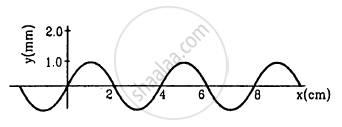Advertisements
Advertisements
प्रश्न
A transverse harmonic wave on a string is described by y(x, t) = 3.0 sin (36 t + 0.018 x + π/4)
Where x and y are in cm and t in s. The positive direction of x is from left to right.
(a) Is this a travelling wave or a stationary wave?
If it is travelling, what are the speed and direction of its propagation?
(b) What are its amplitude and frequency?
(c) What is the initial phase at the origin?
(d) What is the least distance between two successive crests in the wave?
उत्तर १
(a) Yes; Speed = 20 m/s, Direction = Right to left
(b) 3 cm; 5.73 Hz
(c) `pi/4`
(d) 3.49 m
Explanation:
(a) The equation of a progressive wave travelling from right to left is given by the displacement function:
y (x, t) = a sin (ωt + kx + Φ) … (i)
The given equation is:
`y(x,t) = 3.0 sin (36t + 0.018 x + pi/4)` ...(ii)
On comparing both the equations, we find that equation (ii) represents a travelling wave, propagating from right to left.
Now, using equations (i) and (ii), we can write:
ω = 36 rad/s and k = 0.018 m–1
We know that:
`v = omega/(2pi)` and `lambda = (2pi)/k`
Also
= νλ
`:. v = (omega/2pi) xx ((2pi)/k) = omega/k`
`= 36/0.018 = 2000 "cm/s" = 20 "m/s"`
Hence, the speed of the given travelling wave is 20 m/s.
b) Amplitude of the given wave, a = 3 cm
Frequency of the given wave:
`v =omega/(2pi) = 36/(2xx3.14)= 5.73 "Hz"`
(c) On comparing equations (i) and (ii), we find that the initial phase angle, `phi = pi/4`
(d) The distance between two successive crests or troughs is equal to the wavelength of the wave.
Wavelength is given by the relation: k = `(2pi)/lambda`
`:. lambda = (2pi)/k = (2xx3.14)/(0.018) = 348.89 cm = 3.49 m`
उत्तर २
The given equation is y(x,t) = `3.0 sin (36t + 0.018x + pi/4)` , where x and y are in cm and t in s.
a) The equation is the equation of a travelling wave, travelling from right to left (i.e along -ve direction of x because it is an equation of the type )
`y(x,t) = A sin(omegat + kx + phi)`
Here A = 3.0 cm, `omega = 36 "rad s"^(-1)`, k = 0.018 cm and `phi = pi/4`
:. Speed of wave propagation,
`v = omega/k = (36 " rad s"^(-1))/(0.018 cm^(-1)) = (36 "rad s"^(-1))/(0.018 xx 10^2 "ms^(-1)) = 20 ms^(-1)`
b) Amplitude of wave, A = 3.0 cm = 0.03 m
Frequency of wave `v = omega/(2pi) = 36/(2pi) = 5.7` Hz
c) Initial phase at the origin, `phi = pi/4`
d) Least distance between two successive crests in the wave
`= lambda = (2pi)/k = (2pi)/0.018`
= 349 cm = 3.5 m
APPEARS IN
संबंधित प्रश्न
Given below are some functions of x and t to represent the displacement (transverse or longitudinal) of an elastic wave. State which of these represent (i) a traveling wave, (ii) a stationary wave or (iii) none at all:
y = cos x sin t + cos 2x sin 2t
Longitudinal waves cannot
Mark out the correct options.
Figure shows a plot of the transverse displacements of the particles of a string at t = 0 through which a travelling wave is passing in the positive x-direction. The wave speed is 20 cm s−1. Find (a) the amplitude, (b) the wavelength, (c) the wave number and (d) the frequency of the wave.

Two wires of different densities but same area of cross section are soldered together at one end and are stretched to a tension T. The velocity of a transverse wave in the first wire is double of that in the second wire. Find the ratio of the density of the first wire to that of the second wire.
A transverse wave described by \[y = \left( 0 \cdot 02 m \right) \sin \left( 1 \cdot 0 m^{- 1} \right) x + \left( 30 s^{- 1} \right)t\] propagates on a stretched string having a linear mass density of \[1 \cdot 2 \times {10}^{- 4} kg m^{- 1}\] the tension in the string.
An organ pipe, open at both ends, contains
The phenomenon of beats can take place
Given below are some functions of x and t to represent the displacement (transverse or longitudinal) of an elastic wave. State which of these represent (i) a traveling wave, (ii) a stationary wave or (iii) none at all:
y = 2 cos (3x) sin (10t)
Given below are some functions of x and t to represent the displacement (transverse or longitudinal) of an elastic wave. State which of these represent (i) a traveling wave, (ii) a stationary wave or (iii) none at all:
`"y" = 2sqrt(x - "vt")`
